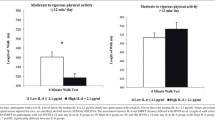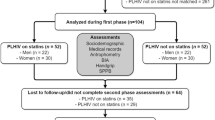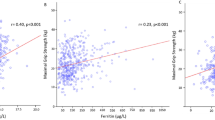Abstract
Little is known about the association between muscle strength and inflammation in diseased individuals and particularly in cardiac patients. Thus, our purpose was to examine the association of muscular strength with the inflammatory status in older adults with and without cardiac disease. The cross-sectional analysis was based on 1079 adults aged 65–94 years, who participated in the KORA-Age study. Participants underwent an interview and extensive physical examinations including anthropometric measurements, registration of diseases and drug intake, determination of health-related behaviors, collection of blood samples for measurements of interleukin-6 and hs-CRP and muscle strength measurement using hand-grip dynamometry. Cardiac patients (n = 323) had higher levels of IL-6 and poorer muscle strength compared with older adults without cardiac disease. Among persons with cardiac diseases, muscle strength in the lower tertile compared to the upper tertile was significantly associated with increased odds of having elevated IL-6 levels (OR 3.53, 95 % CI 1.18–10.50, p = 0.024) after controlling for age, gender, body fat, alcohol intake, smoking status, diseases, medications and physical activity, whereas the association between muscle strength and hs-CRP remained borderline significant (OR 2.80, 95 % CI 0.85–9.24, p = 0.092). The same trends, with slightly lower odds ratios, were also observed in older adults without cardiac disease. Lower levels of muscular strength are associated with higher concentrations of IL-6 and hs-CRP in elderly individuals with and without cardiac disease suggesting a significant contribution of the muscular system in reducing low-grade inflammation that accompanies cardiac disease and aging.


Similar content being viewed by others
References
Krabbe KS, Pedersen M, Bruunsgaard H (2004) Inflammatory mediators in the elderly. Exp Gerontology 39:687–699
Brinkley TE, Leng X, Miller ME et al (2009) Chronic inflammation is associated with low physical function in older adults across multiple comorbidities. J Gerontol A Biol Sci Med Sci 64:455–461
Lauretani F, Russo CR, Bandinellu S et al (2003) Age-associated changes in skeletal muscles and their effect on mobility: an operational diagnosis of sarcopenia. J Appl Physiol 95:1851–1860
Roubenoff R, Parise H, Payette HA et al (2003) Cytokines, insulin-like growth factor 1, sarcopenia and mortality in very old community-dwelling men and women: the Framingham Heart Study. Am J Med 115:429–435
Hansson G (2005) Inflammation, atherosclerosis and coronary artery disease. N Engl J Med 352:1685–1695
Esposito K, Pontillo A, Di Palo C, Giugliano G, Masella M, Marfella R et al (2003) Effect of weight loss and lifestyle changes on vascular inflammatory markers in obese women: a randomized trial. JAMA 289(14):1799–1804
Petersen AM, Pedersen BK (2005) The anti-inflammatory effect of exercise. J Appl Physiol 98:1154–1162
Volaklis KA, Tokmakidis SP, Halle M (2013) Acute and chronic effects of exercise on circulating endothelial progenitor cells in healthy and diseased patients. Clin Res Cardiol 102(4):249–257
Gielen S, Adams V, Mobius-Winkler S et al (2003) Anti-inflammatory effects of exercise training in the skeletal muscle of patients with chronic heart failure. J Am Coll Cardiol 42(5):861–868
Palmefors H, Duttaroy S, Rundqcist B, Boeriesson M (2014) The effects of physical activity or exercise on key biomarkers in atherosclerosis: a systematic review. Atherosclerosis 235:150–161
Swardfager W, Herrmann N, Cornish S, Mazereeuw G, Marzolini S, Sham L et al (2012) Exercise intervention and inflammatory markers in coronary artery disease: a meta-analysis. Am Heart J 163(4):666–676
Dopheide JF, Scheer M, Doppler C, Obst V, Stein P, Vosseler M, et al (2015) Change of walking distance in intermittent claudication: impact on inflammation, oxidative stress and mononuclear cells: a pilot study. Clin Res Cardiol. doi:10.1007/s00392-015-0840-5
Lara Fernandes J, Serrano CV Jr, Toledo F, Hunziker MF, Zamperini A, Teo FH et al (2011) Acute and chronic effects of exercise on inflammatory markers and B-type natriuretic peptide in patients with coronary artery disease. Clin Res Cardiol 100(1):77–84
Febbraio MA, Pedersen BK (2002) Muscle-derived interleukin-6: mechanisms for activation and possible biological roles. FASEB J 16:1335–1347
Pedersen B (2011) Muscles and their myokines. J Exp Biol 214:337–346
Visser M, Pahor M, Taafe DR et al (2002) Relationship of interleukin-6 and tumor necrosis factor-alpha with muscle mass and muscle strength in elderly men and women: the Health ABC Study. J Gerontol A Biol Sci Med Sci 57(5):M326–M332
Cesari M, Penninx BW, Pahor M, Lauretani F, Cordi AM, Rhys-Williams G et al (2004) Inflammatory markers and physical performance in older persons: the InCHIANTI study. J Gerontol A Biol Sci Med Sci 59:242–248
Schaap LA, Pluijm SM, Deeg DJ, Visser M (2006) Inflammatory markers and loss of muscle mass (sarcopenia) and strength. Am J Med 119:526e9–526e17
Brinkley T, Leng X, Miller M et al (2009) Chronic inflammation is associated with low physical function in older adults across multiple comorbidities. J Gerontol A Biol Sci Med Sci 64:455–461
Hamer M, Molloy G (2009) Association of C-reactive protein and muscle strength in the English Longitudinal Study of Aging. Age 31:171–177
Tiainen K, Hurme M, Hervonen A, Luukaala T, Jylha M (2010) Inflammatory markers and physical performance among nonagenarians. J Gerontol A Biol Sci Med Sci 65(6):658–663
Löwel H, Döring A, Schneider A, Heier M, Thorand B, Meisinger C et al (2005) The MONICA Augsburg surveys—basis for prospective cohort studies. Gesundheitswesen Suppl 1:S13–S18
Helbig AK, Döring A, Heier M, Emeny RT, Zimmermann AK, Autenrieth CS, Ladwig KH, Grill E, Meisinger C (2013) Association between sleep disturbances and falls among the elderly: results from the German Cooperative Health Research in the Region of Augsburg-Age study. Sleep Med 14(12):1356–1363
Segal KR, Van Loan M, Fitzgerald PI, Hodgdon JA, Van Italie TB (1988) Lean body mass estimation by bioelectrical impedance analysis: a four-site cross-validation study. Am J Clin Nutr 47:7–14
Chaudhry S, Jin L, Meltzer D (2005) Use of a self-report-generated Charlson Comorbidity Index for predicting mortality. Med Care 43:607–615
Washburn RA, Smith KW, Jette AM, Janney CA (1993) The physical activity scale for the elderly (PASE): development and evaluation. J Clin Epidemiol 46:153–162
Mühlberger N, Behrend C, Stark R, Holle R (2003) Datenbankgestützte Online-Erfassung von Arzneimitteln im Rahmen gesundheitswissenschaftlicher Studien. Erfahrungen mit der IDOM-Software. Informatik, Biometrie und Epidemiologie in Medizin und Biologie 34(4):601–611
Goodman MN (1991) Tumor necrosis factor induces muscle protein breakdown in rats. Am J Physiol 260:E727–E730
Volaklis K, Smilios I, Spassis A, Zois C, Douda H, Halle M, Tokmakidis S (2015) Acute pro- and anti-inflammatory responses to resistance exercise in patients with coronary artery disease: a pilot study. J Sport Sci Med 14(1):91–97
Kritchevsky SB, Cesari M, Pahor M (2005) Inflammatory markers and cardiovascular health in older adults. Cardiovasc Res 66:265–275
Ridker PM, Rifai N, Stampfer MJ, Hennekens CH (2000) Plasma concentration of interleukin-6 and the risk of future myocardial infarction among apparently healthy men. Circulation 101:1767–1772
Acknowledgments
The KORA-Age study was part of the program “Health in Old Age”, which was financed by the German Federal Ministry of Education and Research (BMBF FKZ 01ET0713). The KORA-Age project was conducted on the KORA platform (KORA, Cooperative Health Research in the Region of Augsburg), which was initiated and financed by the Helmholtz Zentrum München, German Research Center for Environmental Health, Neuherberg, and funded by the German Federal Ministry of Education, Science, Research and Technology as well as the State of Bavaria. The funders had no role in study design, data collection and analysis, decision to publish, or preparation of the manuscript.
Conflict of interest
On behalf of all authors, the corresponding author states that there is no conflict of interest.
Author information
Authors and Affiliations
Corresponding author
Additional information
C. Meisinger and B. Thorand contributed equally.
Rights and permissions
About this article
Cite this article
Volaklis, K.A., Halle, M., Koenig, W. et al. Association between muscular strength and inflammatory markers among elderly persons with cardiac disease: results from the KORA-Age study. Clin Res Cardiol 104, 982–989 (2015). https://doi.org/10.1007/s00392-015-0867-7
Received:
Accepted:
Published:
Issue Date:
DOI: https://doi.org/10.1007/s00392-015-0867-7




